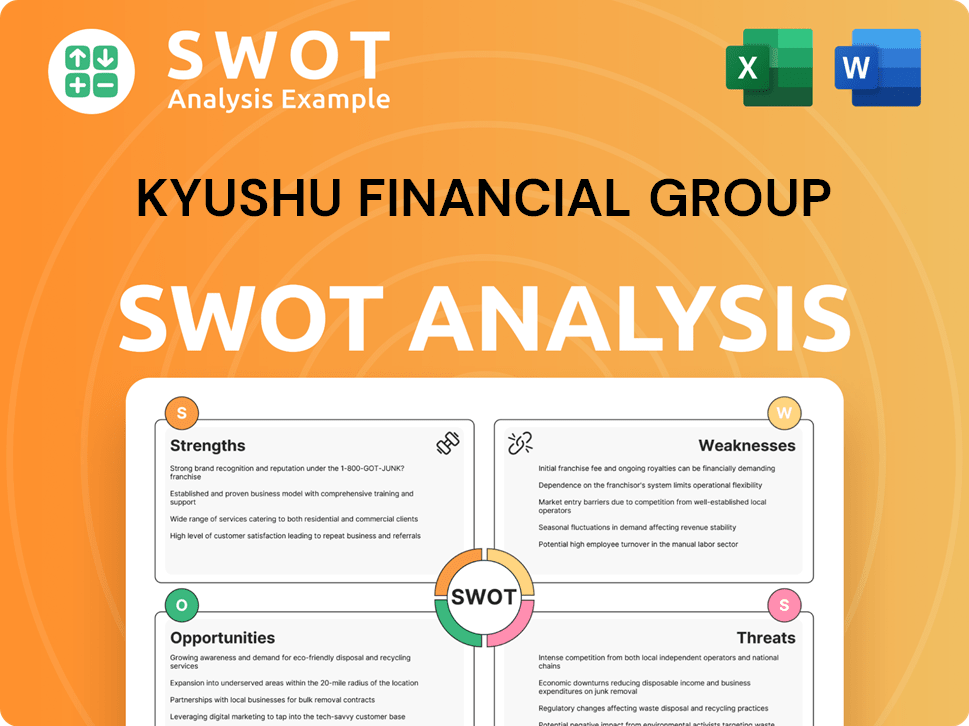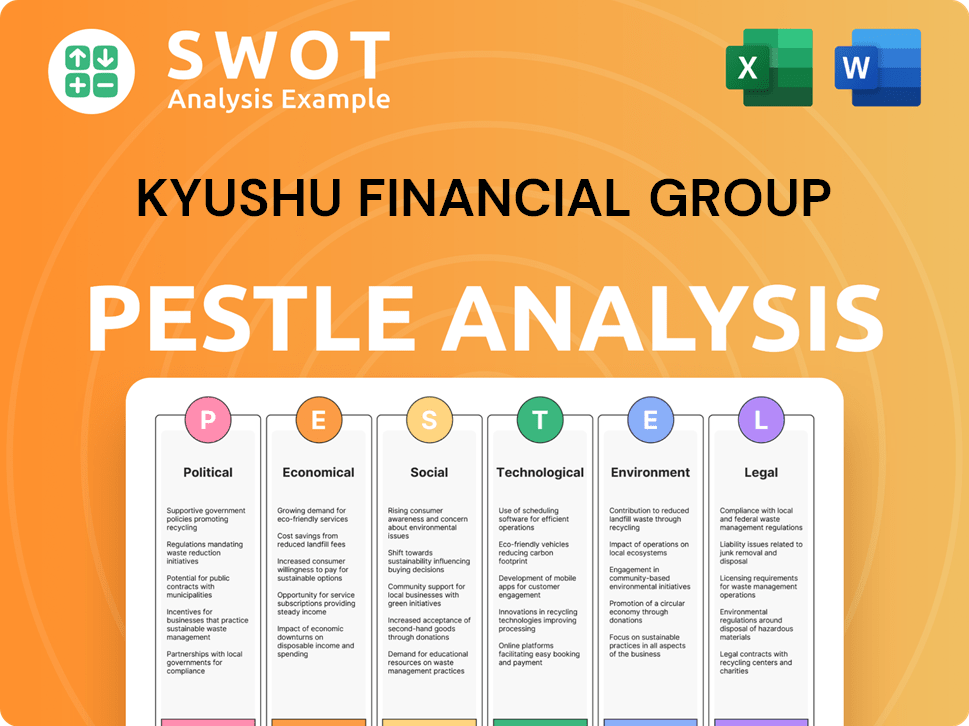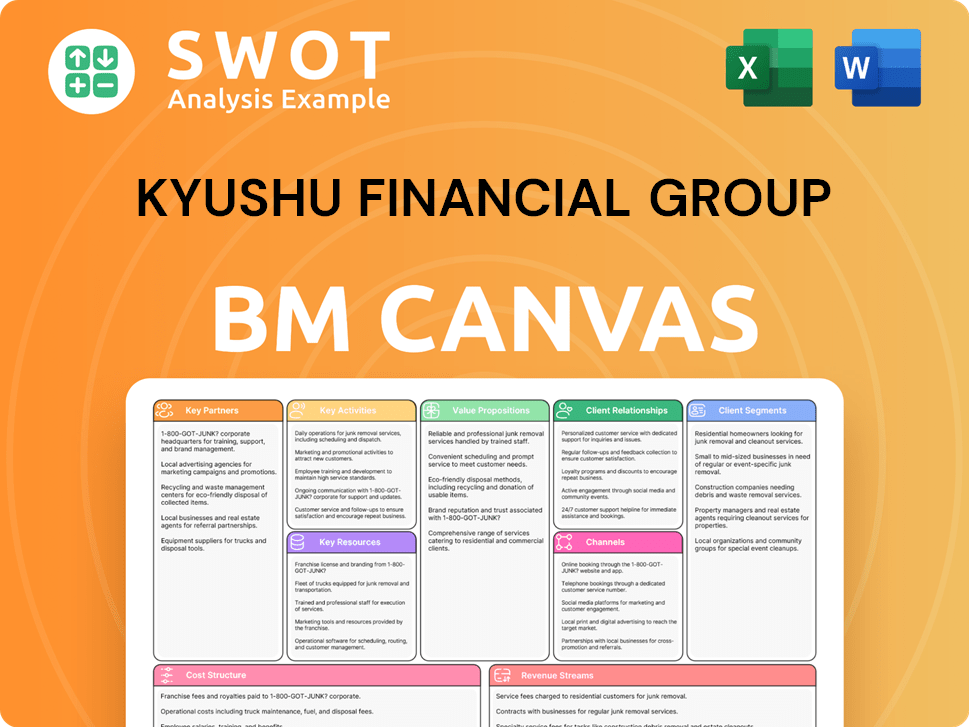Kyushu Financial Group Bundle
Who Really Controls Kyushu Financial Group?
In the complex world of finance, understanding the ownership structure of a major player like Kyushu Financial Group (KFG) is crucial. The formation of a holding company often signals a strategic shift, and KFG, established in 2015, is no exception. This exploration dives deep into the Kyushu Financial Group SWOT Analysis to uncover the key players shaping its future.

This analysis of KFG ownership will examine its foundational structure, the roles of key investors, and the distribution of public shareholdings. We'll explore who owns Kyushu Financial Group, providing insights into its governance, operational strategies, and commitment to regional development. Understanding the KFG shareholders and the overall Kyushu Financial Group structure is key to assessing its resilience and future growth prospects. This will help you to understand if the Japanese government owns Kyushu Financial Group.
Who Founded Kyushu Financial Group?
The establishment of Kyushu Financial Group (KFG) in 2015 marked a significant consolidation in the Japanese financial sector. This formation was not the result of a typical startup but rather a strategic merger between two prominent regional banks: Higo Bank and Kagoshima Bank. As such, the concept of individual founders in the traditional sense doesn't apply; instead, the early ownership structure was a direct reflection of the existing shareholders of the merging entities.
The early ownership of KFG was a straightforward exchange of shares. Shareholders of Higo Bank and Kagoshima Bank effectively became shareholders of the newly formed KFG. The integration was orchestrated by the leadership teams of the two banks, including their presidents and board members, who negotiated the terms of the merger. This approach highlights a strategic consolidation rather than a venture-backed startup model.
The primary driver behind KFG's formation was to create a stronger financial institution capable of better serving the Kyushu region. This strategic move aimed to enhance the financial services offered and create a more robust entity. The consolidated control and diversified shareholder base that emerged from the merger reflected this vision.
KFG's formation was a strategic merger, not a startup.
Early ownership was determined by the share exchange between Higo Bank and Kagoshima Bank shareholders.
The leadership of Higo Bank and Kagoshima Bank were the key architects of KFG's formation.
The merger aimed to create a stronger financial entity for the Kyushu region.
There were no traditional angel investors or early funding rounds.
The merger was governed by legal and regulatory frameworks.
Understanding the KFG's target market and its ownership structure is crucial for investors and stakeholders. Here's a breakdown of the key aspects of KFG ownership:
- KFG shareholders primarily consist of institutional investors and individual shareholders who held shares in Higo Bank and Kagoshima Bank before the merger.
- The Kyushu Financial Group structure is a holding company model, with subsidiaries including the core banking operations of Higo Bank and Kagoshima Bank.
- Information regarding KFG ownership can be found in the company's annual reports and investor relations materials.
- The Kyushu Financial Group parent company oversees the operations of its subsidiaries, ensuring strategic alignment and financial oversight.
- As of the latest financial reports, the major shareholders are primarily institutional investors. The exact percentages fluctuate, but these institutions collectively hold a significant portion of the outstanding shares.
- The Kyushu Financial Group stock ownership details are available through official filings with the relevant regulatory bodies, providing transparency into the shareholder base.
Kyushu Financial Group SWOT Analysis
- Complete SWOT Breakdown
- Fully Customizable
- Editable in Excel & Word
- Professional Formatting
- Investor-Ready Format

How Has Kyushu Financial Group’s Ownership Changed Over Time?
The ownership structure of Kyushu Financial Group (KFG) has primarily evolved through market activities since its establishment in 2015. As a publicly traded entity, its ownership is dispersed among various institutional investors and individual shareholders trading on the Tokyo Stock Exchange. The initial market capitalization reflected the combined value of Higo Bank and Kagoshima Bank, which formed the basis of KFG.
Significant shifts in shareholding often involve large institutional investors adjusting their stakes. These include asset management firms, mutual funds, and pension funds. The evolution of ownership has generally aimed at enhancing corporate value and stability, with strategic decisions being influenced by a broad base of shareholders.
| Shareholder Type | Description | Typical Stake |
|---|---|---|
| Institutional Investors | Asset management firms, mutual funds, pension funds | Variable, often significant |
| Individual Shareholders | Retail investors | Smaller, dispersed holdings |
| Life Insurance Companies & Domestic Corporations | Strategic investors | Moderate to significant |
As of March 31, 2024, key institutional investors include The Master Trust Bank of Japan, Ltd. (Trust Account) and Custody Bank of Japan, Ltd. (Trust Account), which hold shares on behalf of various trusts and pension funds. Specific percentages for these major institutional holders frequently fluctuate based on their investment strategies. Other major stakeholders also include life insurance companies and domestic corporations. Individual insiders, while holding some shares, typically do not possess a controlling stake due to the dispersed nature of public ownership. These changes have reinforced KFG's strategy of regional economic contribution and prudent financial management. Read more about their Growth Strategy of Kyushu Financial Group.
The ownership of Kyushu Financial Group is primarily influenced by market dynamics and institutional investors.
- Major shareholders include asset management firms and trust accounts.
- Individual ownership is dispersed, with no single controlling entity.
- Ownership evolution supports corporate value and regional economic contributions.
- Regularly check KFG's annual reports for the latest shareholder information.
Kyushu Financial Group PESTLE Analysis
- Covers All 6 PESTLE Categories
- No Research Needed – Save Hours of Work
- Built by Experts, Trusted by Consultants
- Instant Download, Ready to Use
- 100% Editable, Fully Customizable

Who Sits on Kyushu Financial Group’s Board?
The Board of Directors of Kyushu Financial Group (KFG) oversees the company's operations and represents the interests of its shareholders. As of mid-2024, the board typically includes a mix of executive directors, who are also senior management within the group, and independent outside directors. This composition aims to balance operational expertise with external oversight, ensuring sound corporate governance. The specific individuals and their affiliations can change, but the structure generally remains consistent.
The board's role is crucial in strategic decision-making and ensuring accountability to all shareholders. The board's composition is designed to promote transparency and align strategic decisions with the long-term interests of the company and the Kyushu region it serves. Information on the current board members and their roles can usually be found in the company's annual reports and investor relations materials.
| Board Member Category | Description | Typical Role |
|---|---|---|
| Executive Directors | Senior management within the group | Oversee day-to-day operations, implement strategies |
| Independent Outside Directors | Individuals with no direct ties to the company | Provide external oversight, ensure independent decision-making |
| Directors Representing Major Shareholders | Affiliated with large institutional investors (if any) | Represent shareholder interests, participate in strategic discussions |
The voting structure of Kyushu Financial Group is generally based on a one-share-one-vote principle, common for publicly traded companies in Japan. This means that voting power is directly proportional to the number of shares held. For further insights into the company's structure, you can explore the Revenue Streams & Business Model of Kyushu Financial Group. There are no known special voting rights or dual-class shares that would grant outsized control to any single entity. Information on KFG shareholders and the company's financial reports can be found in their investor relations materials.
The Board of Directors at Kyushu Financial Group is structured to balance operational expertise with independent oversight, ensuring accountability to all shareholders.
- The board includes both executive and independent directors.
- Voting power is based on a one-share-one-vote principle.
- Information on shareholders and financial reports can be found in investor relations materials.
- The governance structure promotes transparency.
Kyushu Financial Group Business Model Canvas
- Complete 9-Block Business Model Canvas
- Effortlessly Communicate Your Business Strategy
- Investor-Ready BMC Format
- 100% Editable and Customizable
- Clear and Structured Layout

What Recent Changes Have Shaped Kyushu Financial Group’s Ownership Landscape?
Over the past few years (2022-2025), the ownership profile of Kyushu Financial Group (KFG) has been shaped by the economic environment. The company, like other regional banks in Japan, regularly assesses its capital allocation strategies. The Japanese banking sector has seen consolidation, a trend that influences KFG's strategic outlook. The initial formation of KFG was part of this industry-wide trend.
Leadership transitions are normal in mature organizations, and any changes are typically announced with succession plans. There have been no recent public announcements of new strategic investors that significantly altered the ownership structure. Industry trends show increasing institutional ownership across the Japanese stock market, potentially leading to more dispersed ownership for companies like KFG. The company's public statements and analyst reports continue to focus on strengthening its financial base and adapting to digital transformation, which indirectly influences investor confidence and ownership patterns. No plans for privatization or major new public listings have been announced.
| Aspect | Details | Status (2024-2025) |
|---|---|---|
| Share Buybacks | Regular assessments based on market conditions. | Ongoing, as part of capital allocation strategy. |
| Mergers & Acquisitions | Industry consolidation continues. | KFG not involved in major new mergers. |
| Institutional Ownership | Increasing trend across the Japanese stock market. | Likely to lead to more dispersed ownership. |
Understanding the Marketing Strategy of Kyushu Financial Group can also offer insights into how the company positions itself and interacts with its shareholders, which indirectly affects ownership dynamics. The focus remains on financial strength and regional revitalization.
KFG's ownership structure is primarily influenced by institutional investors and public shareholders. The company is listed on the Tokyo Stock Exchange. The ownership structure is subject to market dynamics and regulatory requirements.
Information about KFG shareholders can be found in their annual reports and investor relations materials. These reports offer details on major shareholders and ownership percentages. Regular filings with the Tokyo Stock Exchange also provide updates.
There have been no significant changes in the ownership structure due to mergers or acquisitions. The focus is on strengthening its financial base and adapting to digital transformation. The company has not announced any plans for privatization.
KFG continues to monitor market conditions and regulatory changes. The company's strategic focus on regional revitalization and digital transformation is expected to influence investor confidence. Any changes will be communicated through official channels.
Kyushu Financial Group Porter's Five Forces Analysis
- Covers All 5 Competitive Forces in Detail
- Structured for Consultants, Students, and Founders
- 100% Editable in Microsoft Word & Excel
- Instant Digital Download – Use Immediately
- Compatible with Mac & PC – Fully Unlocked

Related Blogs
- What are Mission Vision & Core Values of Kyushu Financial Group Company?
- What is Competitive Landscape of Kyushu Financial Group Company?
- What is Growth Strategy and Future Prospects of Kyushu Financial Group Company?
- How Does Kyushu Financial Group Company Work?
- What is Sales and Marketing Strategy of Kyushu Financial Group Company?
- What is Brief History of Kyushu Financial Group Company?
- What is Customer Demographics and Target Market of Kyushu Financial Group Company?
Disclaimer
All information, articles, and product details provided on this website are for general informational and educational purposes only. We do not claim any ownership over, nor do we intend to infringe upon, any trademarks, copyrights, logos, brand names, or other intellectual property mentioned or depicted on this site. Such intellectual property remains the property of its respective owners, and any references here are made solely for identification or informational purposes, without implying any affiliation, endorsement, or partnership.
We make no representations or warranties, express or implied, regarding the accuracy, completeness, or suitability of any content or products presented. Nothing on this website should be construed as legal, tax, investment, financial, medical, or other professional advice. In addition, no part of this site—including articles or product references—constitutes a solicitation, recommendation, endorsement, advertisement, or offer to buy or sell any securities, franchises, or other financial instruments, particularly in jurisdictions where such activity would be unlawful.
All content is of a general nature and may not address the specific circumstances of any individual or entity. It is not a substitute for professional advice or services. Any actions you take based on the information provided here are strictly at your own risk. You accept full responsibility for any decisions or outcomes arising from your use of this website and agree to release us from any liability in connection with your use of, or reliance upon, the content or products found herein.